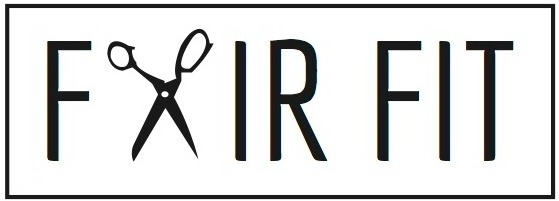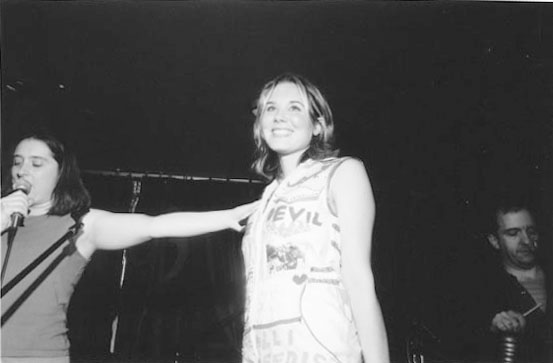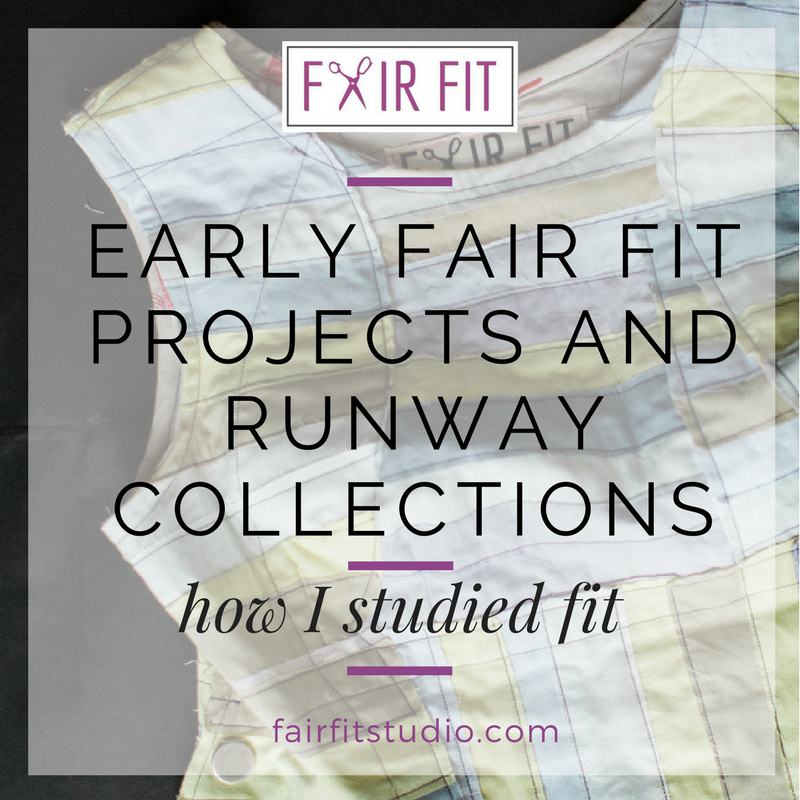Learning Fit and Fairness in My First Collections
It has been over the course of 3 small businesses, centered on clothing, that I created the perspectives and concepts under which I define Fair Fit to mean. I've been at this a long time, before there was Etsy, Pinterest, and Instagram to form and bring awareness to a fashion brand. And as I discussed in my first post, one of the core concepts that I think Fair Fit means is creating fair relationships.
As I discussed in last weeks post, fairness in my practice, teaching, and business began when other folks began to wear the clothes I made. This process of dressing other people made me aware of how fair relationships are formed, and it shaped my perspectives into "fair fit" and "fair fashion".
I elaborate more on this in last week's post that is the start of this series. It describes more of why I use the name Fair Fit, and what it means, through sharing my personal professional history as an artist and fashion designer. You will need to read the posts in order so as not to lose key takeaways and concepts to learn in the series.
I'll pick up where the story left off last week, when I started to form my first business and had my first understandings of the lessons of "fair fit."
My first collection
Back in 2002 to 2005, I focused on creating a fashion presence for myself by presenting my collections the way musicians perform their music. I would partner with bands, book a venue, and ask my friends to perform their interpretations of the dress and the character that it embodied. These were not your usual garments, rather they were visual signage with text and images that portrayed feminine persona in our media and popular culture.
These dresses were cutting edge in 2002- a take on the punk and riot girl movement in the 90's embodied so well by bands like Bikini Kill, Sleater Kinney, and Babes in Toyland, characters like Courtney Love and Kathleen Hanna. I had grown up studying that movement, and loved its influences on fashion, and with my art degree I had learned that a work of art has a voice and presents what's at stake. I brought this to clothing design.
Early Dresses with my Friends. Chicago, 2003. Image by Brian Stusse
At this time, DIY was exploding too, people were sick of the mall and having to wear what everyone else had. There was not internet fashion retail yet to go and find whatever you wanted. At the time, boutiques were popping up that wanted to support independent designers in order to bring something new and one of a kind to their customers. They WANTED extremely small minimums, one of a kinds, and crafts and sewing that had not been seen before. It was a great time to be an emerging fashion designer.
During this period of my development I was presenting shows at least once a month, and doing larger shows, mostly in New Orleans where I was based. I also traveled to New York, Chicago, and London to do a show in those cities. At the time, I was supporting myself by working retail in a very small boutique in the French Quarter. I had not yet thought as to how these shows and performances were going to pay for my time and efforts. I was so absorbed in each show and making each one an incredible experience.
My First Show, with Claudia Gonson and the Magnetic Fields. NYC, 2002. Image by Gail O'Hara
When people wanted to actually buy the dresses seen on stage these shows, I started to consider it. At the time, I really only had the art and music fields as my examples as to how artists are supported financially in the world. In my 20-something brain, I had seen that an artist does a show in a gallery, and someone buys that piece. I saw that musicians were paid for their performances and filled out their income with cd's and t-shirts.
I could not sell the dresses for the stage, because they were a part of a continuing story and if I sold them at the price of a piece of clothing, rather than a work of art, the story would end and it wouldn't be worth the price. The dresses were elaborate, hand stitched, one of a kinds, and each one played off the other. When it came time for a show in New Orleans, I thought, why don't I produce one of a kinds that were faster and lighter versions of the elaborate stage costumes? And sell them on a rack at the show, like musicians sold t-shirts.
That simple ah ha moment is what lead me into this long journey of a small clothing business.
That's when I think I officially became a fashion designer
Instead of hand stitching, I used silkscreen- another medium that I loved for its capacity to transfer imagery and communicate graphic design. It's also a lot faster. I repurposed, tore into existing clothes that I thrifted and combined them into punk rock one of a kinds that were fantastical and truly of that time. There was raw edging, ripped lace, paint, and layers of text over image. It also had a sense of irreverent and sarcastic humor that attracted people sick of the conventions during this period. I was a 20 something living it up in pre-Katrina New Orleans. That was a very special time because there was a very underground fashion scene going on with plenty of room to participate.
For the first show, I made probably 30 pieces, all different sizes, and styles, and hung them on a rack. They sold really well. I was super excited about the extra money and produced a little more inventory for the next show. I could see that this would be a great way to start making a little bit of cash from all these performances.
However, it was bigger than that. The week after the show, I got a call from a local boutique. He was so excited, and asked if I was the designer who was making the printed clothing with phrases and images he saw on visitors to his store. He asked me if I had more, and to bring everything I had to his store as soon as I could. I loaded everything into two big bags, packed them on my bike tied down by bungee cords, and rode my way uptown to his store on Magazine Street. He went through it all, and bought all of my inventory. And I left with a check for almost $2000 that day.
My First Fashion Line. Clothing and Images from 2004-2005.
Now, I was officially in a small business endeavor
I had never made that much money in my life at one time! He sold it fast, and asked for more. This was the start of my first partnerships. I had to hire contractors to help me sew and print. I had to learn how to increase my inventory, produce more, and maintain quality as well. And more stores were interested- I started working with small boutiques in Brooklyn and Asheville along with my New Orleans store. To 20 something me, this was amazing growth!
Let's pop the bubble.
It felt like the time of the greatest potential and I was so excited at the thought I could really be supported and paid doing something that came so naturally to me. But I really didn't have a clue at first as to what I was doing and I told you this story was about how I learned and formed my personal concept of fair fashion. Working in fashion provided me an opportunity to learn how to work with other people and learn how they wanted to wear clothing. Now, let's time travel a bit to go further into the concept.
The thing about criticism
I've always been someone who from an early age got quite a sting when someone offered critical opinion. Not that I don't respect other people's views, it was a reaction in how I received it. I would take it to mean there was something wrong with me- not what I had made. Can you see how big of a problem this could become?
My mom recently told a story during our family time together at Christmas. I don't remember this, but it left an historic impression on my entire family. As soon as I could hold a crayon and get it pressed upon paper, I would draw and color happily. And my mom informed me, I had a definite way I wanted those drawings to look. At age 3, I was at a family get together to get to know my uncle's new wife, my new Aunt Maria. And she was such a lovely, beautiful, and unique woman. She wanted to sit down and color with me, and as we colored, she started to offer her input as to how I should color Dorothy from the Wizard of Oz. She started to throw out lots of ideas, and potentials, surely to inspire three year old me. The family, my mom, and uncles and aunts, warned her, "watch out, you don't want to go there with this 3 year old..." they had learned from experience that it does not go well.
And it did not go well, all of the sudden I just exploded into crying and my mom and dad had to leave the gathering and take me and my brother home because I would not calm down.
Maybe that's typical three year old behavior, but what I recognize in this story is how it feels to react to feedback at times. Sometimes when you know you can't match your vision to the feedback another person is giving you, it can feel like you are overwhelmed. Either because you as the maker didn't think of that, or didn't want to think of that, and that conflict can be frustrating to creatives.
In higher education creatives are taught to learn through critique, but we aren't taught how to receive critique. I will dare to say, that no matter how evolved and detached you have learned to become in the face of criticism, that it still has a sting, even if it's just a little one.
Think about how you have felt when you made something, and you show it to another person, and they ask you to do it another way AND maybe then, they might like it. Have you ever sewn a dress, and someone said like, "well, that's great for you, but I'd only wear it if it was a pencil skirt- that's not flattering for me." Or how about, "if it just didn't have that kind of neckline, I'd wear it."
If you pick up on those types of input as criticism, and start applying outside input even if it's constructive, that it can cause you to stray from your original intention. But this is going to happen all of the time, if you put ANYTHING into the world.
I'm starting to recognize now that "criticism" can be recognized as another person thinking through what they want to do- not necessarily what I should do.
That feels a lot better, but I learning this lesson sidetracked me at times. When I put things into the world, for every 20 "that's awesome, I love it" I would get the 5 "I like it but's.....". And I was too young and inexperienced as a human and as a maker to know how to receive the "I like it buts." Sometimes, it really made me scream like my three year old me coloring with my wonderful aunt. And other times, I took it all on, thinking I should things the way I'm told.
Not all feedback is bad, lots of times when both people are being acknowledged it's helpful. But when you don't know how to receive it and weigh its importance, it can really spin you off in directions you aren't meant to go.
Fashion Collaboration in My Chicago Studio, 2009.
And when you make a product to sell, there is an even more complex exchange between two people. The ante is raised when money is exchanged in order to ensure each party gets what they paid for. And while I was learning the in's and out's of dealing with a retail store, I really had to learn a lot about this side of the exchange. And in the business world "I like it buts" meant the loss of a sale.
While I was working to develop the understanding that now in this retail exchange, I'm in collaboration with a client, I got lost in trying to please to make the pain of the "I like it but" diminish. I'd actually go out and make the darn thing, and then put THAT redesign out there. And of course it wouldn't sell, and I'd be stuck with that Frankenstein skirt that took a lot of my energy because it wasn't even my creation in the first place.
I am still learning, that when you put a work of art or design into the world, it activates others. I'm learning that some will buy it, because it speaks to them, some will appreciate it, because it inspires them, and some may critique it because it provokes them to consider other ways of being and it brings out their unique perspective and critical thinking.
Now I feel the "I like it buts" are more of a conversation of "this is inspiring, this is speaking to me, but it makes me want to go in this direction."
And that's a really cool place to be.
To be fair, it shouldn't be pressed on the designer to make what another uniquely envisions. And to be fair, the other person shouldn't have to rely on another person to get what they want to see, or wear, in this world. It's not black and white, because there's always the chance that the designer agrees. They thought the design was missing something too. But if not, and it's way outside the scope of the idea, then what just exchanged was a conversation and should be left at that.
Ideally, the person with the "I like it but" opinion goes and tries their idea for themselves, because what is emerging is their own ideas and those should be honored and hopefully they take it seriously if they have enough of those moments to learn it.
Unfortunately, I never got the opportunity to practice this understanding in my first collections, because this was 2005, and in August Katrina hit and I lost that business. My studio was in New Orleans, and New Orleans became unlivable. All of my friends who participated and supported me in my business were scattered everywhere, and without the main store in New Orleans, I lost almost all income.
The next year, I pieced together the business by selling to a few stores outside of New Orleans, and doing two major markets. Etsy had officially launched and I sold some of my inventory there. But New Orleans was really my base, and I was struggling to participate without that network of support.
Retail was also transitioning too, and I was overwhelmed. It really broke my heart to never complete the project, or see the potential of my first clothing line, but at the time I decided I needed to start over and get some more perspectives. So I closed that business and enrolled in my graduate program at The School of the Art Institute of Chicago.
In next week's article, I'm going to share with you what came out of learning how to balance input and criticism of fashion, why people wear a garment, and why they don't, and show you the first project that I developed to learn how to transcend the limits of our fashion designer and client collaboration. This became a body of work and research that produced some really interesting things :)
See you next week!










